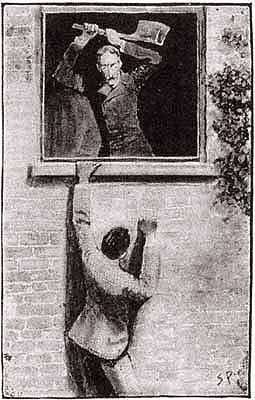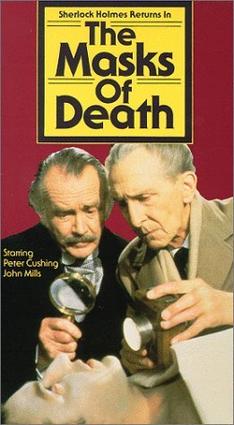Related Research Articles

"The Adventure of the Mazarin Stone" is one of 12 Sherlock Holmes short stories by Arthur Conan Doyle in The Case-Book of Sherlock Holmes (1927). It was first published in The Strand Magazine in the United Kingdom in October 1921, and was also published in Hearst's International in the United States in November 1921.

"The Adventure of the Engineer's Thumb", one of the 56 short Sherlock Holmes stories written by Sir Arthur Conan Doyle, is the ninth of the twelve stories collected in The Adventures of Sherlock Holmes. The story was first published in The Strand Magazine in March 1892. Within the narrative of the story, Dr. Watson notes that this is one of only two cases which he personally brought to the attention of Sherlock Holmes.

"The Adventure of the Norwood Builder", one of the 56 short Sherlock Holmes stories written by Sir Arthur Conan Doyle, is the second tale from The Return of Sherlock Holmes. The story was first published in Collier's (US) on 31 October 1903 and in The Strand Magazine (UK) in November 1903.

The Return of Sherlock Holmes is a 1905 collection of 13 Sherlock Holmes stories, originally published in 1903–1904, by British writer Arthur Conan Doyle. The stories were published in the Strand Magazine in Britain and Collier's in the United States.
Arthur Wontner was a British actor best known for playing Sir Arthur Conan Doyle's master detective Sherlock Holmes in five films from 1931 to 1937.

Eille Norwood was an English stage actor, director, and playwright best known today for playing Sherlock Holmes in a series of silent films.

The Masks of Death is a 1984 British mystery television film directed by Roy Ward Baker and starring Peter Cushing as Sherlock Holmes and John Mills as Doctor Watson.
Sherlock Holmes is a film series running from 1931 to 1937. Arthur Wontner portrayed Sherlock Holmes in five films.

The Hound of the Baskervilles is a 1921 British silent mystery film directed by Maurice Elvey and starring Eille Norwood, Catina Campbell and Rex McDougall. It is based on the 1902 Sherlock Holmes novel The Hound of the Baskervilles by Arthur Conan Doyle. It was made by Stoll Pictures, Britain's largest film company at the time. It was the first British film adaptation of the famous novel.

Hubert Willis was a British actor best known for his recurring role as Doctor Watson in a series of silent Sherlock Holmes films co-starring with Eille Norwood.
The Sign of Four is a 1923 British silent mystery film directed by Maurice Elvey and starring Eille Norwood, Isobel Elsom and Fred Raynham. The film is based on the 1890 novel The Sign of the Four by Arthur Conan Doyle, and was one of a series of Sherlock Holmes films starring Norwood.
The Valley of Fear is a British silent adventure film of 1916 directed by Alexander Butler and starring Harry Arthur Saintsbury, Daisy Burrell and Booth Conway. The film is an adaptation of the 1915 novel, The Valley of Fear by Arthur Conan Doyle featuring Sherlock Holmes. This is now considered a lost film.

The Hound of the Baskervilles is a 1972 American made-for-television mystery film directed by Barry Crane and starring Stewart Granger as Sherlock Holmes and Bernard Fox as Doctor Watson. The movie is based on Arthur Conan Doyle's 1902 Sherlock Holmes novel The Hound of the Baskervilles.
Der Hund von Baskerville is a 1914 German silent film adaptation of Arthur Conan Doyle's 1902 novel The Hound of the Baskervilles, the first film adaptation of the work. According to the website silentera.com, the film was considered lost, but has been rediscovered; the Russian Gosfilmofond film archive possesses a print, while the Filmmuseum München has a 35mm positive print.
The Hound of London is a television film directed by Peter Reynolds-Long and starring Patrick Macnee as Arthur Conan Doyle's character Sherlock Holmes.
The Devil's Foot is a 1921 British short film directed by Maurice Elvey starring Eille Norwood as Sherlock Holmes.
The Dying Detective is a 1921 British short film directed by Maurice Elvey. The film is the first in the Stoll Pictures' short film series The Adventures of Sherlock Holmes.

The Man with the Twisted Lip is a 1921 British short silent film directed by Maurice Elvey. It is the eighth film in Stoll's Adventures of Sherlock Holmes series starring Eille Norwood as the detective.

The Hound of the Baskervilles is a 1929 German silent mystery film directed by Richard Oswald and starring Carlyle Blackwell, Alexander Murski, Livio Pavanelli. The film is an adaptation of the 1902 Sherlock Holmes novel The Hound of the Baskervilles by Arthur Conan Doyle. It was the last Sherlock Holmes adaptation in the silent film era. The film boasted an unusually international cast, including American actor Carlyle Blackwell, German actor Fritz Rasp, British actress Alma Taylor, Russian actor Alexander Murski and Italian actor Livio Pavanelli.
The Return of Sherlock Holmes is a play written by J. E. Harold Terry and Arthur Rose and originally starring Eille Norwood as Sherlock Holmes. The play premiered at Princes Theatre on October 9, 1923.
References
- 1 2 3 Barnes, Alan (2002). Sherlock Holmes on Screen. Reynolds & Hearn Ltd. p. 13. ISBN 1-903111-04-8.
- ↑ King, Susan (9 December 2009). "On the trail of the cinematic Sherlock Holmes". Los Angeles Times . Retrieved 1 January 2012.
- 1 2 Eyles, Allen (1986). Sherlock Holmes: A Centenary Celebration . Harper & Row. pp. 62. ISBN 0-06-015620-1.
- 1 2 Barnes, Alan (2002). Sherlock Holmes on Screen. Reynolds & Hearn Ltd. p. 14. ISBN 1-903111-04-8.
- 1 2 Starrett, Vincent (1993). The Private Life of Sherlock Holmes . Otto Penzler Books. p. 156. ISBN 1-883402-05-0.
- 1 2 Boström, Mattias (2018). From Holmes to Sherlock . Mysterious Press. p. 158. ISBN 978-0-8021-2789-1.
- ↑ Barnes, Alan (2002). Sherlock Holmes on Screen. Reynolds & Hearn Ltd. p. 61. ISBN 1-903111-04-8.
- ↑ Barnes, Alan (2002). Sherlock Holmes on Screen. Reynolds & Hearn Ltd. p. 53. ISBN 1-903111-04-8.
- ↑ Barnes, Alan (2002). Sherlock Holmes on Screen. Reynolds & Hearn Ltd. p. 172. ISBN 1-903111-04-8.
- 1 2 Barnes, Alan (2011). Sherlock Holmes on Screen. Titan Books. pp. 13–14, 64–66, 76, 104–105, 235. ISBN 9780857687760.
- ↑ Eyles, Alan (1986). Sherlock Holmes: A Centenary Celebration. Harper & Row. p. 131. ISBN 0-06-015620-1.
- ↑ Starrett, Vincent (1993). The Private Life of Sherlock Holmes . Otto Penzler Books. pp. 156–157. ISBN 1-883402-05-0.
- ↑ Barnes, Alan (2002). Sherlock Holmes on Screen. Reynolds & Hearn Ltd. p. 15. ISBN 1-903111-04-8.